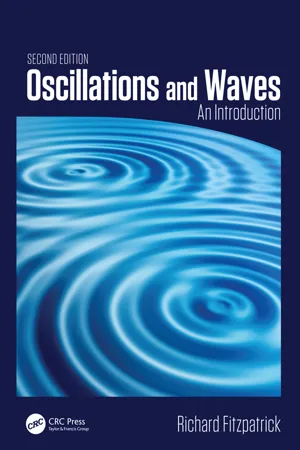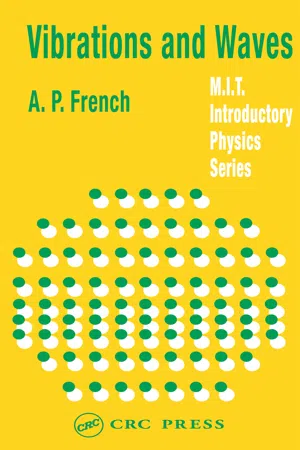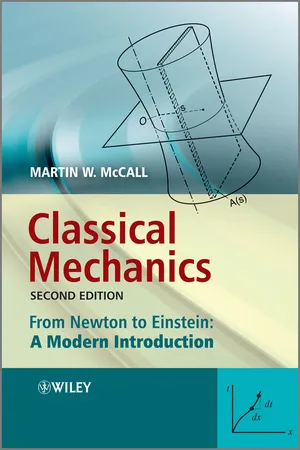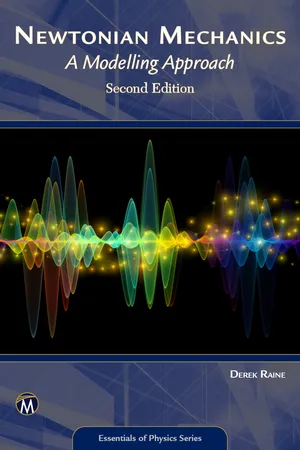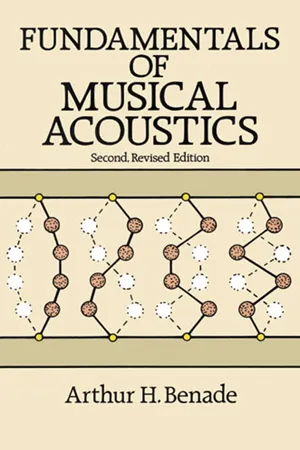Physics
Damped Driven Oscillator
A damped driven oscillator refers to a system in physics where an oscillating object is subjected to both damping (loss of energy) and an external driving force. The damping reduces the amplitude of the oscillations over time, while the driving force continuously supplies energy to the system. This interplay between damping and driving leads to complex behavior in the oscillator's motion.
Written by Perlego with AI-assistance
Related key terms
Related key terms
1 of 4
Related key terms
1 of 3
7 Key excerpts on "Damped Driven Oscillator"
- eBook - ePub
- A. L. Stanford, J. M. Tanner(Authors)
- 2014(Publication Date)
- Academic Press(Publisher)
The mathematics necessary to treat these systems in detail, differential equations, is beyond the scope of this text. Nevertheless, physical descriptions of these systems are included here because they introduce two important concepts of physics that help us to understand—in an intuitive way, at least—some physical situations that are common to everyday experience. First, we shall describe damped oscillations, back-and-forth motions that lose energy as time passes, which correspond to actual oscillating systems. Then we shall consider forced oscillations, those driven by an external agent. These oscillators are considered in order to introduce resonance, a phenomenon seen in many physical systems. Damped Oscillations Oscillators that we can actually observe do not move forever with undiminished amplitude. Unless energy is supplied from a source outside the oscillator, it loses energy, and its amplitude decreases as time goes on. Swinging pendula, for example, eventually come to rest. A real mass oscillating on a spring finally comes to rest. How are these facts consistent with our descriptions of simple harmonic oscillators? Real oscillators are not, of course, the ideal models we have been analyzing. We have not accounted for the losses of energy that actual oscillators experience. To do so, it is necessary to recognize that damping forces—forces that reduce, or damp, the amplitude of oscillation—are present on actual oscillators. Damped oscillations, therefore, result from air resistance; from friction in various forms; or from dampers, devices that are designed expressly to reduce the amplitude of an oscillatory motion. In an ideal oscillatory system, the only force acting on the moving particle is the restoring force that is always directed toward the center of the oscillatory path. In oscillators that experience damping, an additional force acts on the particle in a direction that is opposite to the direction of the velocity of that particle at every instant - eBook - ePub
Oscillations and Waves
An Introduction, Second Edition
- Richard Fitzpatrick(Author)
- 2018(Publication Date)
- CRC Press(Publisher)
CHAPTER 2Damped and Driven Harmonic Oscillation
2.1 INTRODUCTIONIn the previous chapter, we encountered a number of energy conserving physical systems that exhibit simple harmonic oscillation about a stable equilibrium state. One of the main features of such oscillation is that, once excited, it never dies away. However, the majority of the oscillatory systems that we encounter in everyday life suffer some sort of irreversible energy loss while they are in motion, due, for instance, to frictional or viscous heat generation. We would therefore expect oscillations excited in such systems eventually to be damped away. The aim of this chapter is to examine so-called damped harmonic oscillation, and also to introduce the differential equation that governs such motion, which is known as the damped harmonic oscillator equation. In addition, we shall examine the phenomenon of resonance in periodically driven, damped, oscillating systems. In this chapter, examples are again drawn from simple mechanical and electrical systems.2.2 DAMPED HARMONIC OSCILLATIONConsider the mass–spring system discussed in Section 1.2 . Suppose that, as it slides over the horizontal surface, the mass is subject to a frictional damping force that opposes its motion, and is directly proportional to its instantaneous velocity. It follows that the net force acting on the mass when its instantaneous displacement is x(t) takes the formf(2.1)(= − k x − m vx ,)x ˙x ˙,where m > 0 is the mass, k > 0 the spring force constant, and v > 0 a constant (with the dimensions of angular frequency) that parameterizes the strength of the damping. The time evolution equation of the system thus becomes [cf., Equation (1.2) ](2.2)x ¨+ vx ˙+ω 0 2x = 0 ,whereis the undamped oscillation frequency [cf., Equation (1.6) ]. We shall refer to the preceding equation as the damped harmonic oscillator equationω 0=k / m - eBook - ePub
- A.P. French(Author)
- 2017(Publication Date)
- CRC Press(Publisher)
4 Forced vibrations and resonance THE PRECEDING CHAPTER was concerned entirely with the free vibrations of various types of physical systems. We shall now turn to the remarkable phenomena, of profound importance throughout physics, that occur when such a system—a physical oscillator—is subjected to a periodic driving force by an external agency. The key word is “resonance.” Everybody has at least a qualitative familiarity with this phenomenon, and probably the most striking feature of a driven oscillator is the way in which a periodic force of a fixed size produces very different results depending on its frequency. In particular, if the driving frequency is made close to the natural frequency, then (as anyone who has pushed a swing knows) the amplitude of oscillation can be made very large by repeated applications of a quite small force. This is the phenomenon of resonance. A force of about the same size at frequencies well above or well below the resonant frequency is much less effective; the amplitude produced by it remains quite small. To judge by the quotation at the beginning of this chapter, the phenomenon has been recognized for a very long time. 1 It is typical of this type of motion that the driven system is compelled to accept whatever repetition frequency the driving force has ; its tendency to vibrate at its own natural frequency may be in evidence at first, but ultimately gives way to the external influence. 1 As Alexander Wood remarks in his book Acoustics (Blackie & Son, London, 1940): “It seems difficult to believe that legislation should be designed to cover a situation that had never arisen.” The example does seem rather bizarre, however, and H - eBook - ePub
Classical Mechanics
From Newton to Einstein: A Modern Introduction
- Martin W. McCall(Author)
- 2011(Publication Date)
- Wiley(Publisher)
to the mass as(3.59)which, as indicated, will depend on time. If P (t )is calculated after the transient has died away we can use Equation (3.33 ) for x (t )and obtainor, using trigonometry,(3.60)Normally we are interested in knowing the power transferred on timescales much greater than T , the oscillator cycle time – the electricity company does not send me a bill every 20ms! – so an appropriate quantity to calculate is the cycle averaged power,(3.61)where T = 2π/ωd. Inserting Equation (3.60 ) into the above integral, the first term cycle averages to zero leaving(3.62)The cycle averaged power is always positive since −π ≤ ϕ ≤ 0, and is maximised for ϕ = −π /2, when the force and the displacement are said to be in quadrature. From Equation (3.39 ), ϕ = −π /2corresponds toωd= ω 0 , which for a lightly damped system is the resonance frequency at which the amplitude is maximised. Utilising Equation (3.41 ) for the maximum amplitude in Equation (3.62 ), gives for the maximum possible power transferable by the external force(3.63)3.13 Coupled OscillationsA forced oscillator system is a ‘master-slave’ system in that the external force compels a mass to move, without the mass itself exerting any influence on whatever is providing the force. We are now going to analyse a system where this asymmetry is removed and the ‘driving force’ becomes part of the system itself. The model system consists of two masses connected by a spring undergoing mutual harmonic motion as shown in Figure 3.18 . As well as occurring frequently in mechanics, coupled oscillator systems are a paradigm for other situations in physics where oscillatory effects are brought into proximity.Two identical masses of mass m are each attached by a spring of constant k to a rigid support and connected to each other by another spring of constant s . The displacements of the masses from their equilibrium positions are x and y - Tamer Bécherrawy(Author)
- 2013(Publication Date)
- Wiley-ISTE(Publisher)
Chapter 3 Forced OscillationsOscillations are said to be forced if the oscillator is permanently subject to external forces as well as internal restoring forces and friction forces. In this chapter we assume that the oscillator is linear ; this is the case for mechanical systems subject to ordinary forces and electric circuits formed by ideal resistors, inductors and capacitors and connected to generators. Then, the superposition principle is valid: if several forces act simultaneously on a linear system, the resulting motion is the superposition of the motions produced by each force acting separately.In this chapter we study the forced oscillations of a system with one or several degrees of freedom especially in the case of a simple harmonic excitation force. The response of the system is particularly important if the excitation frequency is close to the natural frequency or one of the normal frequencies of the system; this phenomenon is called resonance . This study is important because several systems may be modeled as harmonic oscillators, and because the Fourier theory allows us to consider any excitation force as a superposition of harmonic forces.3.1. Transient regime and steady regime
The equation of an oscillator with one degree of freedom, which is subject to an external force F (t ), is where µ is its inertial parameter, −Ku is the restoring force and is the dissipative force. We may also write[3.1 ]F (t ) is a generalized force , that is, any cause that may produce or modify the motion or change the state of a system by supplying or extracting energy. If u is the x -coordinate of a particle, the generalized force is the x -component F x of the ordinary force acting on the particle. If u is the rotation angle about an axis Oz , the generalized force is the z- component of the moment of the forces about O and if u is the charge of a capacitor, the generalized force is the e.m.f.- eBook - ePub
Essentials of Physics Series
A Modelling Approach
- Derek Raine(Author)
- 2021(Publication Date)
- Mercury Learning and Information(Publisher)
For our masses on a spring, this means that the dissipation is most effective if the masses are equal, as we proposed. This is a special example of a more general result that energy transfer is most effective if the impedances of the systems are matched. Our conclusion is that the pendulum will effectively suppress the motion of the tower in the wind if the tower and the pendulum are impedance matched.8.13 CHAPTER SUMMARY• The equation of motion for the displacement of a damped, driven harmonic oscillator iswhere the real parts of complex quantities are to be taken.• Impedance is the ratio of the driving term to the response (displacement)• Resonance occurs when an oscillator is driven by a periodic force close to its natural frequency; the resonant frequency occurs at minimum impedance.• The quality factor Q of an oscillator is defined by and is the number of periods for the amplitude to decline by a factor of e.• In a damped oscillator, the driving term and displacement (or velocity) are out of phase. If the phase difference isϕ, the rate of dissipation is proportional to8.14 EXERCISES1. Once in motion the amplitude of a child’s swing can be increased by pumping the oscillation by adjusting position in time with the swing. Because the effect is to alter the parameters of the swing (its natural length or moment of inertia), the process is called parametric amplification or parametric resonance.Consider therefore an SHO subject to a periodic variation of its natural frequency:(8.42)where ε ≪ 1. If we neglect the perturbation the solution is, say,Settingϕ= 0 for simplicity show that (8.42) can be writtenShow that this gives rise to a linearly growing solution for x (t ). Show further that the power supplied over a cycle is given byand hence that the energy of the oscillator grows exponentially.2. A spherical buoy floats half-submerged in water and is observed undergo small oscillations about this equilibrium position with frequencyω - eBook - ePub
Fundamentals of Musical Acoustics
Second, Revised Edition
- Arthur H. Benade(Author)
- 2012(Publication Date)
- Dover Publications(Publisher)
10Sinusoidally Driven Oscillations
When one plucks a guitar string or strikes a piano string with its hammer, the string is given a complicated motion made up of a collection of characteristic sinusoidal oscillations belonging to the string. We have already investigated this sort of composite motion in considerable detail. We have also seen that soundboards and other two-dimensional objects respond to excitation in a similar fashion. We should now inquire about the way forces exerted by any one of the characteristic sinusoidal oscillations of one object (for instance, a piano string) excite the vibrations of another object (for example, the soundboard on which it is mounted). In simplest terms this question can be reduced to one about the behavior of a single spring-and-mass system when it is driven by a sinusoidally varying force. Once we understand what goes on here, it will prove easy to generalize in familiar ways to learn what takes place when a more complicated system (having several characteristic modes) is sinusoidally driven. Each of these modes will respond to the driving force in the same basic way.Many coffee drinkers have observed that the liquid in a cup has a side-to-side sloshing mode which oscillates with a frequency of about two repetitions /second. This mode is, as a matter of fact, a very close cousin to the single mode of oscillation that was found to take place in a U-tube filled with water (see sec. 6.1 and fig. 6.3 ). The coffee drinker may also know from experience that if he waves his filled cup gently to and fro at a frequency that is even approximately equal to the natural frequency of the fluid, the coffee oscillates ever more wildly, and soon slops out of the cup. That is, repetitive excitation of an object can build up a very large amplitude of oscillation if the excitation frequency is roughly equal to the natural vibration frequency of the object.10.1. Excitation of a Pendulum by a Repetitive Force
Index pages curate the most relevant extracts from our library of academic textbooks. They’ve been created using an in-house natural language model (NLM), each adding context and meaning to key research topics.
Explore more topic indexes
Explore more topic indexes
1 of 6
Explore more topic indexes
1 of 4

